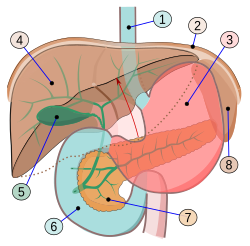

The gallbladder (or cholecyst or gall bladder) is a small non-vital organ that aids in the digestive process and stores bile produced in the liver.
The gallbladder is a hollow organ that sits in a concavity of the liver known as the gallbladder fossa. In adults, the gallbladder measures approximately 8 cm in length and 4 cm in diameter when fully distended.[2] It is divided into three sections: fundus, body, and neck. The neck tapers and connects to the biliary tree via the cystic duct, which then joins the common hepatic duct to become the common bile duct.
- The gallbladder has a simple columnar epithelial lining characterized by recesses called Aschoff's recesses, which are pouches inside the lining.
- Over the epithelium there is a layer of connective tissue (lamina propria).
- Above the connective tissue is a wall of smooth muscle (muscularis externa) that contracts in response to cholecystokinin, a peptide hormone secreted by the duodenum.
- There is, in essence, no submucosa separating the connective tissue from serosa and adventitia, but there is a thin lining of muscular tissue to prevent infection.
- ^ Ginsburg, Ph.D., J.N. (2005-08-22). "Control of Gastrointestinal Function". in Thomas M. Nosek, Ph.D.. Gastrointestinal Physiology. Essentials of Human Physiology. Augusta, Georgia, United State: Medical College of Georgia. pp. p. 30. http://www.lib.mcg.edu/edu/eshuphysio/program/section6/6ch2/6ch2line.htm. Retrieved 2007-06-29.
- ^ Jon W. Meilstrup (1994). Imaging Atlas of the Normal Gallbladder and Its Variants. Boca Raton: CRC Press. pp. 4. ISBN 0-8493-4788-2.
- ^ "Slide 5: Gall Bladder". JayDoc HistoWeb. University of Kansas. http://www.kumc.edu/instruction/medicine/anatomy/histoweb/epithel/epith05.htm. Retrieved 2007-06-29.
- ^ Romer, Alfred Sherwood; Parsons, Thomas S. (1977). The Vertebrate Body. Philadelphia, PA: Holt-Saunders International. p. 355. ISBN 0-03-910284-X.